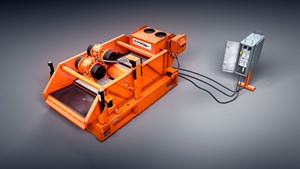Pneumatic fluids, cuttings separator increases fluid recovery, waste reduction

HOUSTON -- Today, strict global onshore and offshore disposal standards are applicable industry-wide. One of the requirements specifies that free fluid must be removed from all cuttings. This can result in increased costs for operators due to higher treatment, disposal and transportation costs. The conventional approach for improving separation uses vibratory separation, which can cause cuttings attrition, compromising efficient solids removal. The technique can also generate formation damaging fines that hinder drilling fluids performance.
Schlumberger's SCREEN PULSE fluid and cuttings separator uses a lightweight pan installed as a drop-in within the flowline shaker bed and underlying the last screen on the discharge end. This simple retrofit installation delivers improved shale shaker performance by producing a suction effect beneath the screen surface, enabling ultra-fine screen separation efficiency, while the pneumatic control panel activates the system on up to three shakers simultaneously. The system also decreases waste disposal costs and reduces heavy machinery movement by generating drier cuttings direct from the shaker.
Optimizing water-based mud recovery in Ecuador
While drilling onshore Ecuador, an operator found that the fluid located within the drilling cuttings was extremely high. As a result, the mud lost in the shakers was more than 75 bopd due to the high-water content. Therefore, multiple additional trips were required to transport the increased amount of drill cuttings, while high volumes of diluted mud increased the volume of generated waste.
The operator selected the SCREEN PULSE separator from Schlumberger to enhance fluid recovery, decrease the mud on cuttings, and reduce waste and disposal costs. The system was installed on three wells, reducing the requirement for expensive waste-treatment chemicals that were previously necessary due to the fluid volume lost to the cuttings. Moreover, the costly base fluid that in past had been discarded, could be recovered, enabling reuse in the active mud systems.
By installing the separator, water content in cuttings decreased by 10% in the upper and intermediate sections and 14% in the final section of all three wells. The drilling waste volume also decreased by 19.3%—as well as leading to reduced waste disposal costs; 58 less waste disposal trips were required. In summary, the separator saved the operator $13,500 per well, including $9,000 in transportation costs and $3,000 in drill cuttings drying operations.


